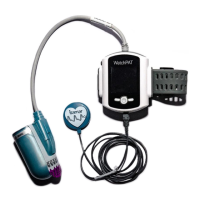What to do if my Itamar Medical Equipment device does not turn ON?

What to do if my Itamar Medical Equipment device does not turn ON?
| Brand | Itamar Medical |
|---|---|
| Model | WatchPAT 300 |
| Category | Medical Equipment |
| Language | English |
Device's purpose, diagnostic aid for sleep disorders.
Rules and conditions for WP300 usage, physician authorization.
Cases where the WatchPATTM300 should not be used due to patient factors.
Special considerations and warnings for pediatric users (12-17 years old).
Parameters like PRDI, PAHI, PSTAGES generated by the device.
Medical device classification under MDD 93/42 EEC.
Compliance with international quality standards for medical devices.
Product compliance with CE marking and TÜV RHEINLAND certification.
Explanation of terms and abbreviations used throughout the manual.
Definitions and importance of warning, caution, and note indicators.
Essential safety instructions to prevent injury or damage to the device.
Explanation of symbols found on the device and its packaging.
Details of the labels affixed to the back of the device.
Information regarding FDA clearance for the device.
Components of the WP300 system, including the device and accessories.
Explanation of the device's buttons, display, and ports.
Channels recorded by the device and data storage/transfer.
Overview of the device's self-testing capabilities for operators and patients.
Procedure for operator-initiated device self-testing before a study.
How to perform and interpret the device self-test results.
Procedure for the patient-initiated self-diagnostic test.
Step-by-step guide for inserting the AAA battery into the WP300 device.
Details on battery types, usage, and replacement recommendations.
Instructions for attaching the adhesive sticker to the sensor.
Notes on cleaning the wrist strap before use.
How to securely attach the WP300 device to the wrist strap.
Warning and procedure for replacing the uPAT probe.
Guidance on preparing the device for a new patient study.
Running the built-in self-diagnostic facility.
How to interpret test results and troubleshoot errors.
Instructions on how to pack the device and accessories into the case.
Explanation of the optional snore and body position sensor.
How to use the tamper-proof bracelet for patient identification.
Information on conducting sleep studies spanning multiple nights.
General cleaning requirements for device components.
Procedure for cleaning the main device and carrying case.
Instructions for cleaning the wrist strap.
Information on the single-use uPAT probe and its disposal.
How to clean the snore and body position sensor.
Guidelines for proper handling and storage of the device.
Step-by-step instructions for replacing the uPAT probe cable.
How to set the device's time and date via the zzzPAT application.
Recommendations for storing the device to maintain its condition.
Pre-application notes for the patient, including hand preparation.
Instructions for mounting the device on the wrist strap.
Detailed guide on correctly attaching the uPAT probe to the finger.
How to power on the device to start recording.
Steps to follow after completing the sleep study.
Final important reminders and contact information for issues.
Outline of the steps to cover during patient demonstration.
Introducing the device, strap, and probe to the patient.
Demonstrating proper application of the device to the patient.
Demonstrating how to turn on the device.
Demonstrating how to remove and store the device.
General guidelines for training patients on device usage.
Discussing safety, common issues, and support contacts.
Guide to understanding and resolving error messages displayed to the operator.
Guide to patient-reported errors and their possible solutions.
Purpose of the integrated sensor for sleep studies.
Steps for preparing the sensor with an adhesive sticker.
How to correctly attach the sensor to the patient's chest.
Recommended method for cleaning the sensor and its cable.
Enabling tamper-proof testing during new study setup in zzzPAT.
Selecting the appropriate tamper-proof bracelet for the study.
Connecting the bracelet cable to the WatchPAT device.
Attaching the bracelet's snap buttons to the device.
Pairing the bracelet and performing a diagnostic test.
How to properly fit the bracelet onto the patient's wrist.
Patient guidance regarding the bracelet and study duration.
